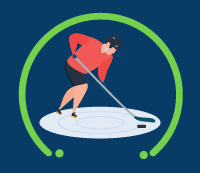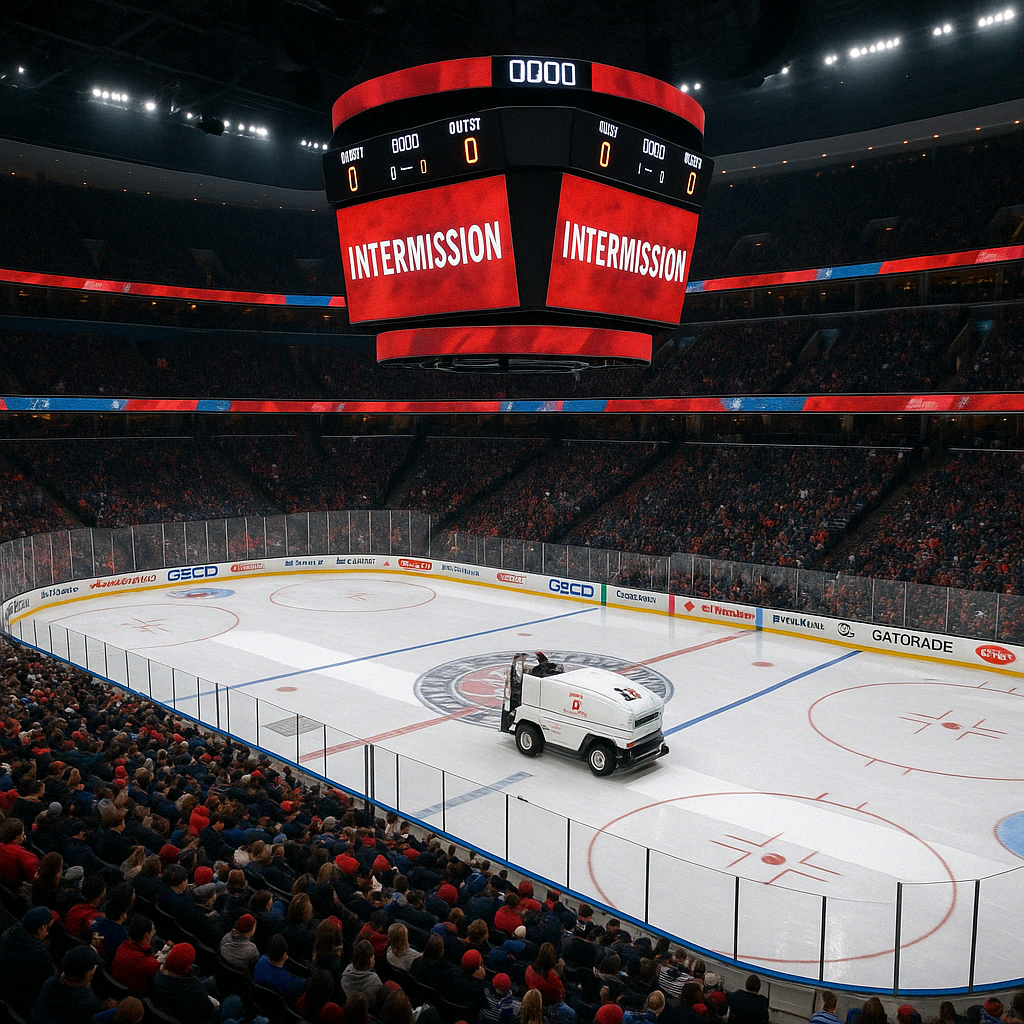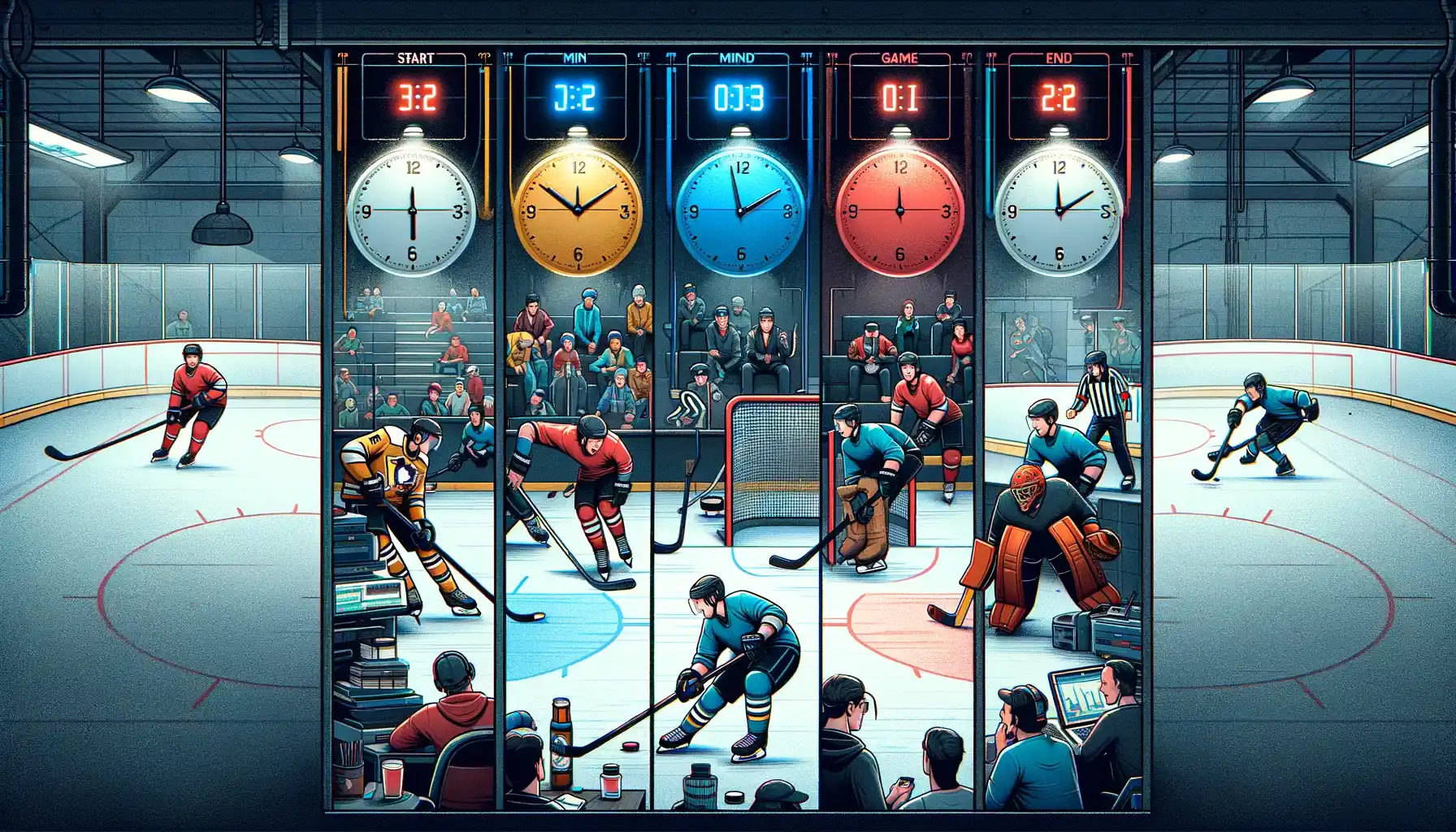Ice Hockey is a very popular sport and you can understand by looking at the fanfare at the Winter Olympics and Stanley Cup Final. Today, I am going to share some of the important rules of hockey that you must understand and follow as a hockey player. This sport has some unique rules that you might not find in other sports. So, read the article and understand the essential rules and regulations of one of the fastest-growing sports across the world.
Be sure to check out my latest article, The Ultimate Guide to Ice Hockey.
Most Important Rules of Ice Hockey
- Basic Structure of the game
- Faceoffs
- Penalties
- Power plays & Penalty kills
- Offside
- Icing
- High Touch
- Line changes
- Pulling Goalie
- Equipment
Below table provides a quick reference guide to the most important rules in ice hockey.
| Rule | Description | Example |
|---|---|---|
| Basic Structure | 6 players per team, 3 periods of 20 minutes each. | Each team has a goalie and 5 skaters on the ice. |
| Faceoffs | Used to start play after a stoppage. | Occurs at beginning of period and after goals are scored. |
| Penalties | Violating rules results in players sent to penalty box for a specified time. | Tripping, high-sticking, roughing. |
| Power plays & Penalty kills | Power play: team with more players due to penalty; Penalty kill: opposing team trying to defend. | Power play has better chance of scoring; penalty kill tries to defend. |
| Offside | Attacking player enters offensive zone before puck. | Play resumes with faceoff outside attacking zone. |
| Icing | Player shoots puck across opponent's goal line from behind own red line without anyone touching it. | Play is stopped, and faceoff is held in defending zone of team that committed icing violation. |
| High Touch | Player touches puck with stick above shoulders. | Play is stopped, and faceoff is held in offending team's defensive zone. |
| Line changes | Players switch positions on ice during play. | Players change in shifts to maintain energy and strategy. |
| Pulling Goalie | Team removes goalie to add extra attacker. | Happens when team is losing and needs to score quickly. |
| Equipment | Players wear skates, helmets, pads, and gloves for safety. | Equipment provides protection from collisions with other players and the puck. |
To improve your ice hockey skills, it’s essential to not only understand the rules of the game but also to develop your skating technique. Check out our comprehensive guide on ice hockey skating drills to enhance your speed, agility, and overall performance on the ice.
Structure of the Game (Basic Rules):
Teams
Each team can have a maximum of 20 players, including two goaltenders, but only six can be on the ice at the same time. Substitutions are permitted at any time throughout the game.
Timings
The game is 3 periods long, 20 minutes each. The period length varies depending on the level of hockey that you are playing. Whenever play stops, the clock is also stopped. It means that every second is important.
Discover the impact of time regulations in our overview of periods in hockey, and for an understanding of overall game duration, see our Average Hockey Game Length guide..
The object of the game
In simple terms, team aims to score more goals than opponents by getting the puck into the opponent’s goal. If only all the pucks cross the whole goal line, then the goal is considered to be scored. The players cannot hit the puck with their kicks as it is illegal so they have to use their sticks for hitting the puck when it is in contact with the ice for scoring. But the deflections of other players including the goalie are considered legal goals.
Playing zone
A series of red and blue lines are marked on the ice and this Is called a hockey rink. The red line is the center line and divides the ice into two halves. The blue line separates the ice into three zones, a defending zone, an attacking zone, and a neutral zone.
Match officials
The person who wears the red armband controls the entire game and takes the final decision on any matter is the referee of the match. He is assisted by linemen concerned with offside and goal judges concerned with deciding whether the puck has crossed the goal line.
Key Takeaways:
- Teams are made up of 20 players, with a maximum of 6 on the ice at any given moment with changes permitted at any time.
- The game is divided into three 20-minute sections, with the clock stopping when play ends.The idea of the game is to score more goals than the opponent by utilizing sticks to get the puck into their goal.
- The playing zone is a hockey rink with red and blue lines separating it into two halves and three zones (defending, attacking, neutral)
- The referee, who wears a red armband, directs the game and makes ultimate decisions, with the help of offside and goal judges.
If you want to learn about the important positions and roles of players in ice hockey, be sure to check out my guide on Ice Hockey Positions
Faceoffs
These always happen after a pause in the play and decide about the beginning of possession. The players took faceoffs from the nine dots on the ice. The dot is chosen based on where the play was left at the stoppage. One player from each team lines up on both sides of the dot and after the referee drops the puck on the dot and the players taking the faceoffs will fight for the puck and try to win it.
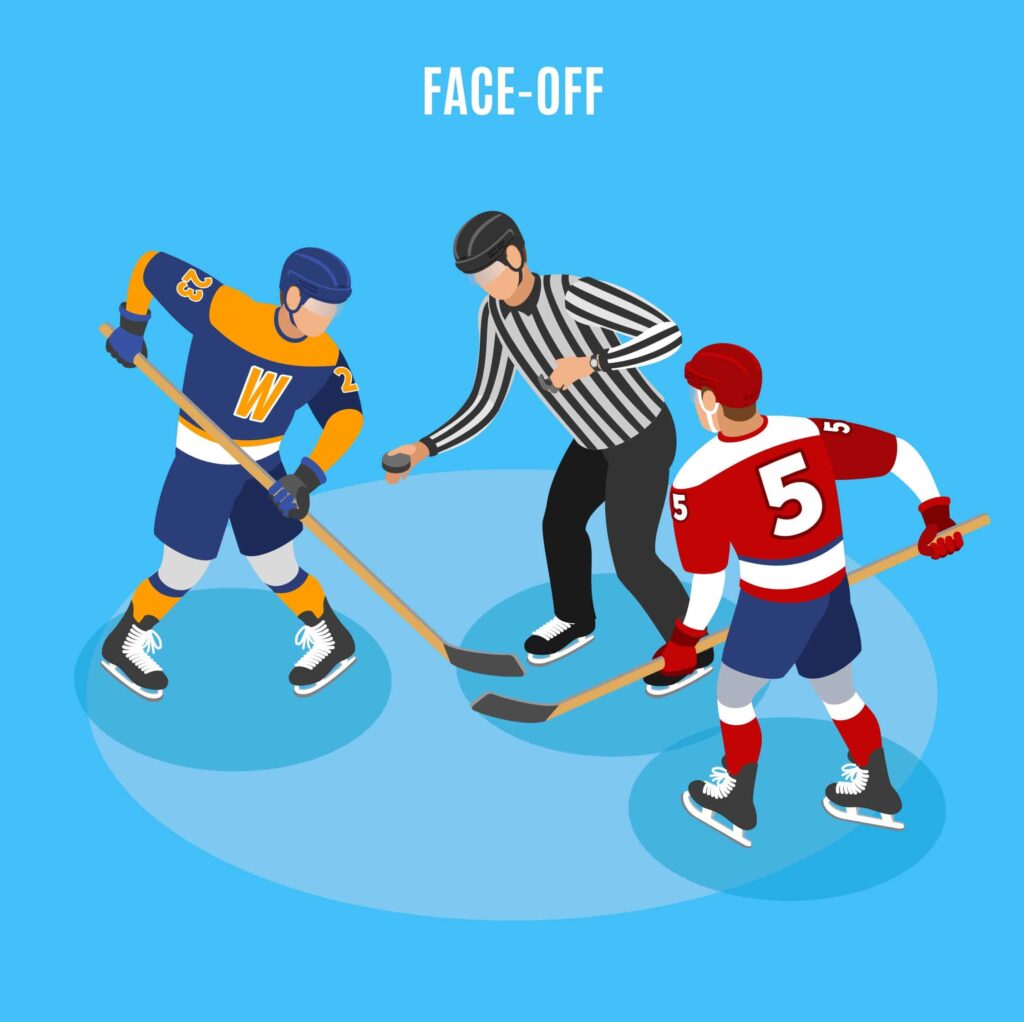
Faceoffs in hockey are very important because winning them will give your team the opportunity to get started with the puck. Besides this, you can score more goals and win more games. In big games, some players are considered faceoff specialists as they excel at winning the faceoffs.
Penalties
In hockey when you commit any mistake or penalty, you are sent to the penalty box. There are mainly types of penalties in hockey minor and major. Besides this, there is misconduct and match penalties.
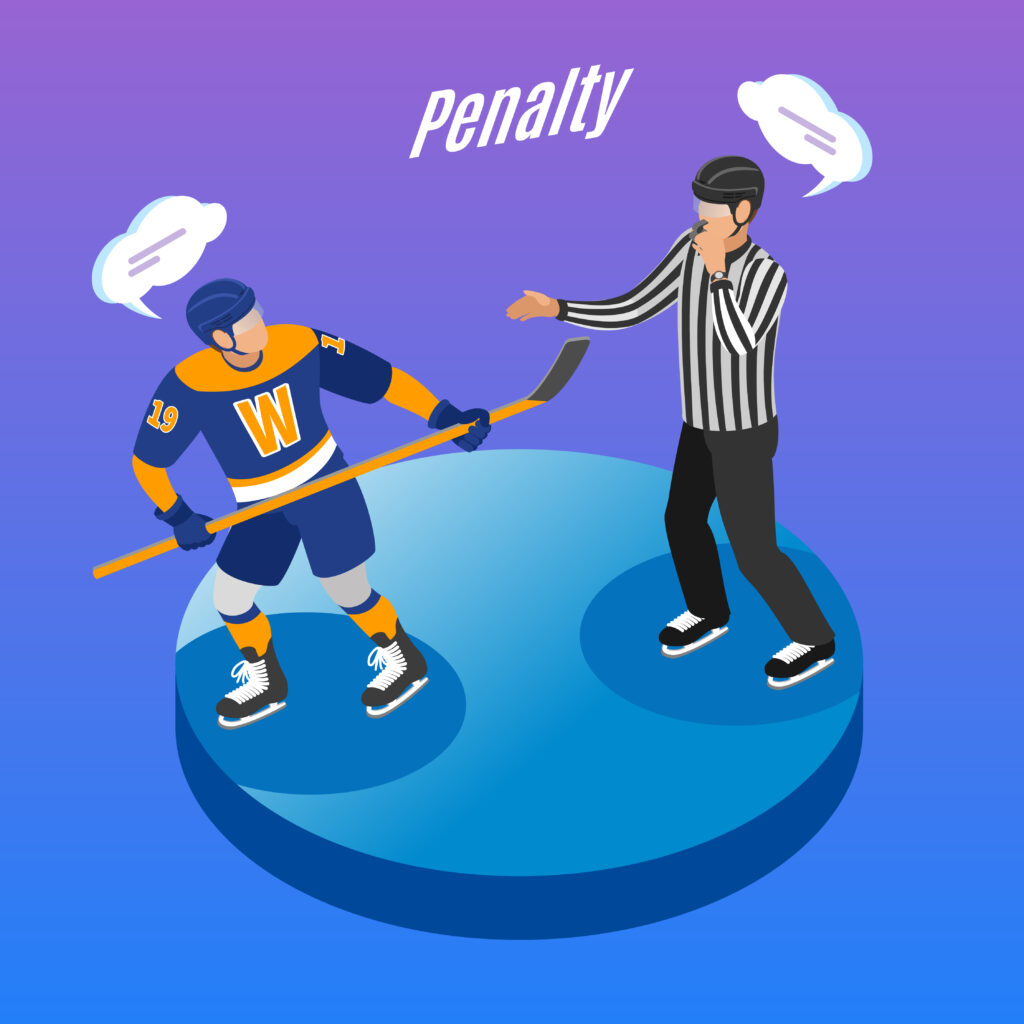
Minor Penalty: A minor penalty lasts for 2 minutes and leads to a power play for the opponent. If your team scores in these two minutes, then you get out of the penalty box. Some examples of minor penalties are tripping, hooking, boarding, high sticking, interference, holding, slashing, roughing, and more.
Major Penalty: A major penalty is caused when the referee stops the play for injuring any player and the offending player is sent to the penalty box for five minutes. If the team committing the major penalty scored during this time then the player in the penalty box doesn’t return. They will have to wait for a complete five minutes for a major penalty.
Understanding the rules of ice hockey is essential, and that includes being familiar with player penalties. For a comprehensive overview, explore our guides on PIM in Hockey and Hockey Penalties to gain valuable insights into the consequences and intricacies of penalties in the game.
Power Plays and Penalty Kills
When any penalty happens in the game, then the teams will either be on the power play or penalty kill. It means that the teams will either be playing on 4v5 or 5v4 for some time depending upon the penalty. If your team commits any penalty, then one of your players will be In the penalty box. It means you will be on the penalty kill and the other team will be on the power play. If the other team commits a penalty, then they will be on the penalty kill and your team will be on the power play.
Offside
Offside in ice hockey is an important rule that helps maintain the flow and balance of the game. It is designed to prevent attacking players from rushing into the opposing team’s defensive zone and having an unfair advantage.

The two blue lines on either side of the ice define this zone. The areas opposite these lines are defensive and offensive zones and the space in between is a neutral zone. Offside is a rule where a player is given offside when they enter the defending zone of the opposite side before the puck. If this happens the play is halted and a faceoff happens between the team in the neutral zone.
When a player is offside, the linesman stops the play immediately and a faceoff takes place at the nearest faceoff spot in the neutral zone. The attacking team is not allowed to touch the puck until all of their players have cleared the defensive zone and are considered onside.
Icing
Another essential rule of ice hockey is Icing. This is when any player on the side of the red center line of his team shoots the puck down the ice and it crosses the red line at any point. Icing is not permissible when teams are on the power play or at equal strength. When this happens, the play is halted and the puck is returned to the other end of the ice for a face-off in the offending team’s zone.
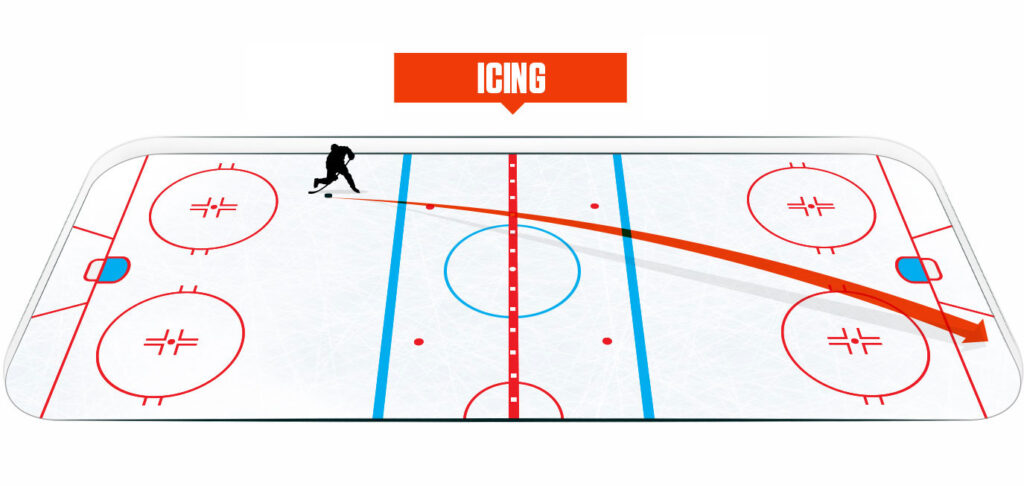
Icing the puck is not called if the goalie leaves the crease for playing the puck without touching it and if a player is ruled out that the player could have played the puck before it crossed the red goal line.
High Touch
In hockey, you can’t touch the puck with the stick if it is higher than your shoulders. This Is because it can be dangerous for the players to swing their sticks above their heads while trying to hit the puck. If a player tries to do such an act, then high touch is called. This halts the play, a faceoff will occur, and no penalty will be given.
Line Changes
Under this rule, any player can change the line at any time during the play. This is different from other sports as in other sports a player has to wait for stopping the play to substitute the players. Players on the bench must have to pay attention to the play on the ice, so they should always be ready to replace their teammates. This feature makes hockey an exciting and fast-paced game.
Pulling the Goalie
The goalie is also allowed to change the line. It means that the coach will signal the goalie to change the line means to sit on the bench and a player will replace him as an extra attacker, leaving the goal unguarded. Having an extra attacker in the game means that you have a better chance of scoring. When there is a delayed penalty, then also a team can make its goalie sit on the bench. To know more how goaltending, read my guide on How to Master the Art of Ice Hockey Goaltending.
Equipment
Since hockey is a dangerous sport, protection is required. In the NHL you don’t have to wear a full cage on your helmet, just a visor is needed for protecting the eyes. But in all other leagues, you need the correct gloves, skates, sticks, and pads. While playing you must ensure to follow all the rules on equipment for ensuring the safety of your own and other players. To learn more about ice hockey equipment, you can read my article on the topic.
Safety is a top priority in ice hockey, and wearing a proper helmet is required by the rules. Learn how to choose the right helmet with our Hockey Helmet Buying Guide to ensure you stay safe and compliant on the ice.
Some more rules
Overtime
Any regular season game that has ended with a tie will go into a sudden death overtime period. If at the end of this period, the game is still a tie, then it will go into a shootout. During the playoffs, there is no shootout and the overtime period is 20 minutes.
Shootout
A series of penalty shots in which each team is allowed to have just three attempts of scoring alternately is a shootout. If even after three attempts the teams are still in a tie position, the shootout will continue until one team is unable to match the other team’s attempts. The winner of the shootout is given a goal.
Penalty shots
This shot is awarded to any player when they are pulled down from behind during a breakaway scoring opportunity or when the net is intentionally dislodged by the opponent’s goalie or defensemen.
Game Delay
Following are the actions that will result in the penalty game delay of two minutes:
- Intentionally batting or shooting the puck outside the playing area
- Failure in providing the accurate number of players on ice after an official warning
- Making an illegal substitution
- Deliberately displace of goal from its actual position
Read my informational guide on different types of hockey helmets and their unique features.
Once you’ve familiarized yourself with the rules of ice hockey, it’s important to equip yourself with top-notch gear from reputable manufacturers. Explore our in-depth list of premier hockey equipment brands to ensure you’re choosing the best products to enhance your performance and safety on the ice.
FAQs on Ice Hockey Rules
What are the dimensions of an ice hockey rink?
An ice hockey rink normally measures 200 feet (61 meters) long and 85 feet (26 meters) wide, with rounded corners. The ice rink is enclosed by boards and glass, and there are two goals, one at each end, measuring 6 feet (1.83 meters) wide and 4 feet (1.22 meters) tall. The blue lines separate the rink into three zones: defensive, neutral, and attacking.
Find out the specific in-depth information on dimensions of hockey goals in our comprehensive analysis.
How long is a typical ice hockey game?
A typical ice hockey game is 60 minutes long, divided into three periods of 20 minutes each. However, with stoppages, intermissions, and overtime, a game can last anywhere from 2-3 hours.
What is the purpose of the blue lines on the ice rink?
The blue lines on an ice rink are essential markings that divide the rink into three areas: the offensive zone, neutral zone, and defensive zone in ice hockey. These lines serve to regulate player and puck movement and determine whether a player is offside or if an icing violation has occurred.
How does overtime work in ice hockey?
In ice hockey, overtime is played when the game ends in a tie. The sudden-death period involves five skaters from each team, with the first to score winning the game. If neither team scores during overtime, the game goes into a shootout with three penalty shots per team, followed by a sudden-death format until one team scores.
What is checking in Ice Hockey?
Checking is a fundamental defensive technique in ice hockey that involves the legal use of body contact to stop an opposing player’s progress or dispossess them of the puck. In other words, it is a way for a defending player to physically impede the movement of an attacking player by using their body to block their path or separate them from the puck.
What is not allowed in ice hockey?
In ice hockey, actions such as tripping, high-sticking, hooking, slashing, boarding, charging, and interfering with an opposing player are not allowed and may result in a penalty or ejection. The rules are designed to promote safety and fair play, and unsportsmanlike conduct may result in disciplinary action.
To improve your physical and mental performance for ice hockey, read my guide to off-ice hockey training. It covers various aspects such as strength, speed, endurance, and cognitive agility.
The Bottom Line
So, these were the basic rules of Ice hockey that I have shared with you. These rules are almost the same in all the leagues. But as time is changing and with this, there might be changes in the game and its rules. So, you must keep yourself updated with both the changing and basic rules as it will help you in developing you as a strong hockey player.
Get ready to take your ice hockey skills to the next level! Check out my beginner’s guide to Ice Hockey Positions and uncover the secrets of each position on the ice. Don’t miss out on the chance to up your game – read it now and let me know your thoughts!
